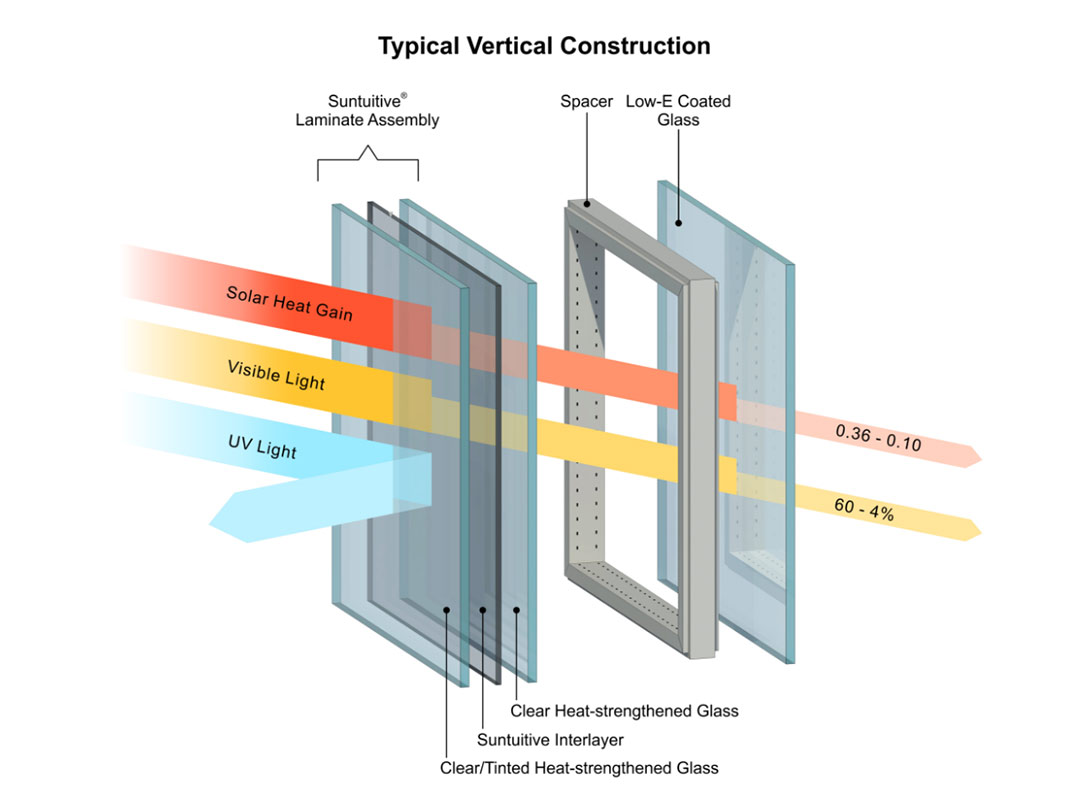Dynamic Glass
Dynamic Glass refers to advanced coatings applied to glass, enabling dynamic adjustments to sunlight and temperature for enhanced energy efficiency. These coatings offer potential benefits in reducing energy consumption for heating and cooling, as well as improving solar panel efficiency.

Image credit: Sunintuitive Glass
View open jobs in this Solution
Example Companies
- View, Inc. - Develops smart windows that adjust to changing sunlight conditions.
- SageGlass - Produces electrochromic glass that tints on demand to control sunlight.
- Heliotrope Technologies - Innovates in dynamic glass technology for energy-efficient buildings.
- Saint-Gobain - Offers a range of dynamic glass solutions for various applications.
- Guardian Glass - Provides advanced glass solutions, including dynamic glass.
Overview
Dynamic Glass refers to advanced coatings applied to glass, enabling dynamic adjustments to sunlight and temperature for enhanced energy efficiency. These coatings offer potential benefits in reducing energy consumption for heating and cooling, as well as improving solar panel efficiency.
Progress Made
Significant advancements have been made in dynamic glass technologies and practices:
- Electrochromic Glass: Glass that changes its light transmission properties when voltage is applied.
- Thermochromic Glass: Glass that changes its light transmission properties in response to temperature changes.
- Photochromic Glass: Glass that darkens when exposed to sunlight and lightens in the absence of sunlight.
Solutions by Sector
Commercial Buildings
- Office Buildings: Dynamic glass reduces glare and heat gain, improving occupant comfort and energy efficiency.
- Retail Spaces: Enhances natural lighting while controlling temperature, reducing HVAC costs.
- Hospitals: Improves patient comfort by controlling light and temperature in patient rooms.
Case Studies:
- View, Inc., USA: Installed dynamic glass in office buildings, reducing energy consumption and improving occupant comfort (View, Inc.).
- SageGlass, USA: Implemented electrochromic glass in commercial buildings to enhance energy efficiency (SageGlass).
- Heliotrope Technologies, USA: Developed dynamic glass solutions for various commercial applications (Heliotrope Technologies).
Residential Buildings
- Smart Windows: Dynamic glass windows that adjust to changing sunlight conditions, improving energy efficiency.
- Skylights: Dynamic glass skylights that control light and heat, enhancing indoor comfort.
- Balconies and Patios: Dynamic glass for outdoor spaces, providing shade and reducing heat gain.
Case Studies:
- Saint-Gobain, France: Installed dynamic glass in residential buildings to improve energy efficiency and comfort (Saint-Gobain).
- Guardian Glass, USA: Provides advanced glass solutions, including dynamic glass, for residential applications (Guardian Glass).
- SageGlass, USA: Implemented dynamic glass in residential projects to enhance energy efficiency and occupant comfort (SageGlass).
Industrial Applications
- Data Centers: Dynamic glass helps control temperature and reduce cooling costs.
- Manufacturing Facilities: Enhances natural lighting while controlling heat gain, improving energy efficiency.
- Warehouses: Reduces glare and heat, enhancing working conditions and reducing energy consumption.
Case Studies:
- View, Inc., USA: Installed dynamic glass in data centers to improve energy efficiency and reduce cooling costs (View, Inc.).
- Heliotrope Technologies, USA: Developed dynamic glass solutions for industrial applications (Heliotrope Technologies).
- Guardian Glass, USA: Provides dynamic glass solutions for industrial buildings to enhance energy efficiency (Guardian Glass).
Lessons Learned
- Technology Stage: Dynamic Glass is still in its early stages, with both successes and failures.
- Effective Implementation: Proper installation and compatibility with local climate are critical.
- Diverse Successes: While challenges exist, Dynamic Glass has been effective in scenarios like office buildings' energy reduction.
- Continuous R&D: Ongoing research and development are crucial for advancing dynamic glass technology.
Challenges Ahead
- High Costs: Current technology costs need reduction for wider adoption.
- Enhancing Efficiency: Improving energy efficiency is vital to attract more users.
- Overcoming Technological Hurdles: Companies like Saint-Gobain and View, Inc. are making progress, but hurdles remain.
- Market Awareness: Increasing awareness about the benefits of dynamic glass.
Best Path Forward
- Clear Objectives: Defining achievable goals aligned with climate change mitigation.
- Thorough Testing: Rigorous research and testing to ensure technology effectiveness.
- Expert Collaboration: Partnering with reputable manufacturers for quality assurance.
- Effective Marketing: Communicating technology benefits through comprehensive strategies.
- Policy Support: Advocating for supportive policies and incentives for dynamic glass adoption.
Image credit: Sunintuitive Glass